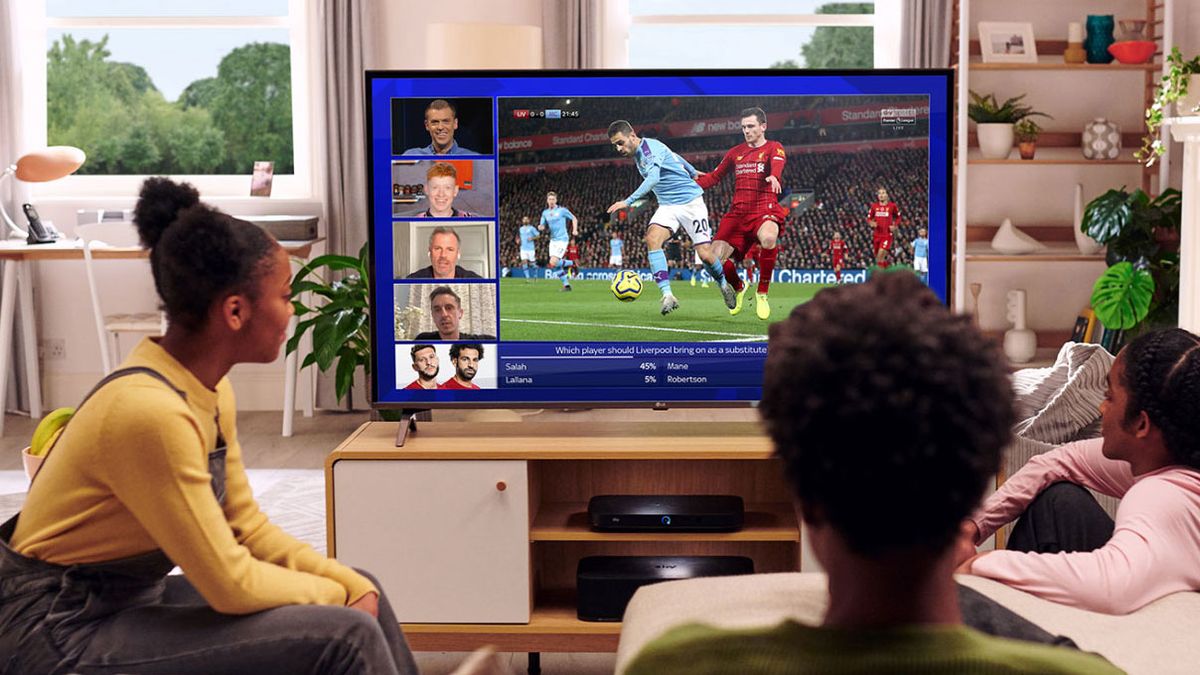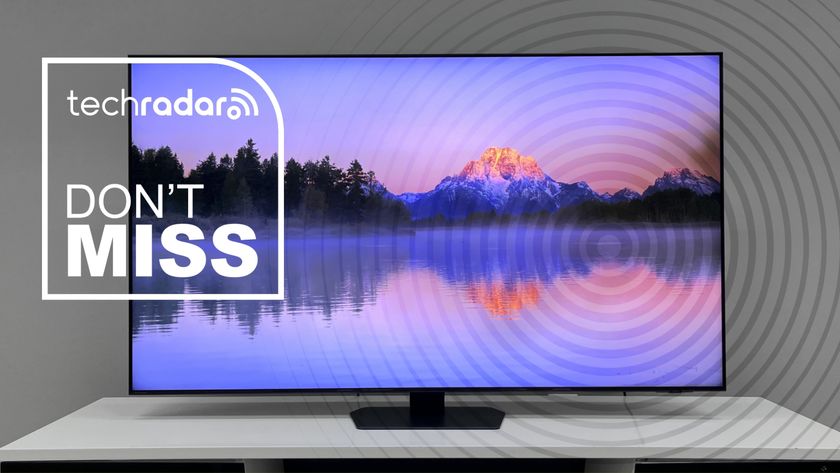Football's canned atmosphere: how crowd noise is added to empty Premier League grounds
Football's equivalent of a laughter track has divided fans

When Manchester City's Raheem Sterling scored the first goal of the restarted Premier League season on Wednesday night, the cheer heard by viewers watching on TV came from a match played in the past.
With pandemic restrictions meaning fans aren't allowed in the grounds, all fixtures for the foreseeable future will be played behind closed doors. Instead, TV companies are turning to technology to provide a virtual atmosphere (insert your own Arsenal joke here).
- Premier League re-start: everything you need to know
- How to watch Premier League: live stream every game online
It's in the game
Anyone who's watched a game without fans in attendance will know what a sterile experience it is. The lonely shouts that echo around the empty stadium are also anathema to the Premier League 'product' that Sky has spent the past 28 years crafting, so almost as soon as fixtures were suspended in March, the broadcaster began thinking about how it could make its coverage feel as normal as possible.
The answer came from EA Sports and FIFA 20 – a series that has been doing its very best to recreate the slickness and sheen of televised football since it started using audio recorded at actual matches in 2014.
After every Premier League ground was added to FIFA 15 a year later, each one now has its own in-game soundtrack, created using audio recorded by Sky during its live broadcasts, which ebbs and flows in response to what's happening on the pitch.
It's this library of football foley sounds (the reproduction of everyday sound effects that are added to media in post-production) that is being used to construct an atmosphere at each of the remaining games when they're shown on TV.
That's why when Raheem Sterling put Manchester City ahead just before halftime, the cheers were actually from an old game at the Etihad that Sky had already shown. How very meta.
Get daily insight, inspiration and deals in your inbox
Sign up for breaking news, reviews, opinion, top tech deals, and more.
Put it in the mixer
So how does it work during a live game? EA Sports has provided Sky with around 13 hours of audio, including team-specific chants, 'oohs' for near misses, and howls of derision for when decisions don't go the way of the home team.
Rather than just forming a bland sonic wallpaper that doesn't reflect the flow of the game, a sound engineer combines these on-the-fly with the live audio to create something akin to a match being played in front of 50,000-odd fans.
Obviously this introduces situations where the engineer must decide how they think a real crowd would react, which could lead more partisan fans to accuse the broadcaster of their favourite thing: bias against their club.
According to Dave Gibbs, Content and Product Director at Sky Sports, there are no official guidelines for the sound engineers to follow. "You're relying on the skill of the engineer to mix it in real time," he tells TechRadar just before the first match of the restarted season. "Ours really understand the flow of the game and how that audio experience works."
Fans can still influence what's heard, albeit in a slightly gimmicky way. Those watching through Sky's app or via the website can use a new Fanzone feature to vote on which chants they want to hear from a carefully chosen selection of TV-friendly options.

Delayed reaction
As with pretty much everything in football – except perhaps the shambles that is VAR – the virtual crowds have divided opinion, but when former footballer and occasional crisp evangelist Gary Lineker polled 180,000 of his Twitter followers on the issue, 75% said they preferred it.
Switching channels and for me it’s a much better experience with the crowd sound effects. Thoughts?June 17, 2020
Many welcomed the dose of familiarity the added audio provides in an otherwise unprecedented situation, while some have bemoaned the fact that it doesn't match the action on the pitch closely enough.
While it's perhaps unfair to judge the tech on just two games, with production teams still getting to grips with an entirely new process as they go, it's easy to see where both sides are coming from.
When Sheffield United's Enda Stevens fired a shot into the side-netting against Aston Villa in the opening game a cheer erupted, as it often does when fans mistakenly think their team has scored, but it faded away just a little bit too quickly.
the biggest giveaway that it wasn't real though, was the fact that it wasn't met by jeers from the opposing fans
Perhaps the biggest giveaway that it wasn't real though, was the fact that it wasn't met by jeers from the opposing fans. Similarly, when Raheem Sterling tripped over his own feet towards the end of Manchester City's win over Arsenal, there was no mocking 'wahey!' from the virtual away end.
On the whole, while the general sonic backdrop is pretty effective, the reactions have felt just a little too delayed. It was telling that the most convincing noise on Wednesday night came after Manchester City's Kevin De Bruyne scored his 51st-minute penalty, when the audio engineer in charge of the cheers would've had more time to prepare the response.
La Liga TV, the UK broadcaster for the Spanish top flight, has been using an almost identical system for its matches, but Sky's approach did feel a little heavy handed in comparison. That's not necessarily just down to the execution of the augmented audio though.
La Liga has also chosen to superimpose a texture onto each stadium's lower tier in an attempt to make it look like the seats are filled with fans – a rudimentary AR effect. If you focus on it, it inevitably looks a bit odd, like they've raided the assets of International Superstar Soccer on the SNES and used them to create a giant desktop wallpaper, but when your eyes are on the game its presence in your peripheral vision seems to play some sort of trick on your brain.
The crowd sounds also seem to be better integrated into the audio mix and genuinely sound like they're coming from within the stadium.
Perhaps using both means the effect is greater than the sum of their parts – our senses work as a team after all – but don't expect to see any similar AR trickery on Sky's coverage of the Premier League any time soon.
"I don't think it's quite ready yet. There are a lot of technical challenges there," says Gibbs, suggesting the ball could get lost easily among the overlay.
The flags and banners covering the empty seats at Villa Park and the Etihad Stadium, however, seemed to have the opposite effect, merely serving as a stark reminder of what – or who – was missing.
Ultra culture
But perhaps that's not a bad thing. Football isn't a TV show and what all of this proves is how crucial fans are to the game, something that more hardcore supporters in Germany have been keen to remind broadcasters since the Bundesliga restarted in May.
They see the artificial crowd effects as disrespectful to the contribution match-going fans make to their club and feel that faking an atmosphere in order to make the 'product' more palatable is unacceptable.
Germany has a much more active and engaged fan culture than the UK, though, largely thanks to its 50+1 rule, which means supporters always have a say in how their clubs are run. So while some fans might moan a bit on social media, did Sky Sports see similar resistance to its own plans for virtual crowds?
"No, we haven't – but we won't force this on anybody," insists Gibbs, referring to the fact that there are two channels: Sky Sports Main Event, which includes the augmented audio, and Sky Sports Premier League, which features a 'clean' version with just the players' shouts and other live sounds. "I think it's important that we give our customers the choice," he says.
With real crowds at stadiums expected to be one of the last things to return to 'normal' as COVID-19 is brought under control, it's a choice that fans at home will have to make for some time to come.
Tom Wiggins is a Freelance Content Manager. He has been writing for various magazines and websites for the past years including MSN South Africa, MSN UK, MSN, MSN Canada, TechRadar, Yahoo Sport UK, Red Bull, JAMA Oncology, TrustedReviews, FourFourTwo, ShortList, Wareable, Stuff India, Stuff (UK), FACT Magazine, Louder, Metro.News, PC & Tech Authority, The Set Pieces, Decrypt Media, FourFourTwo Australia, In Bed With Maradona, The Ambient, Inside Sport, The Baltimore Post, My Office News.













